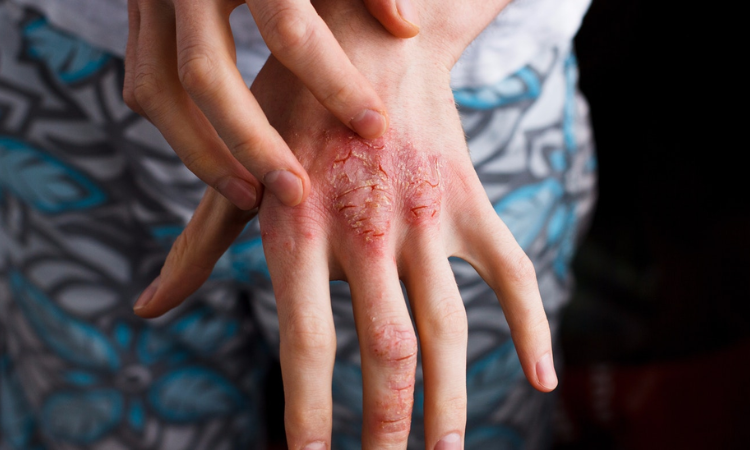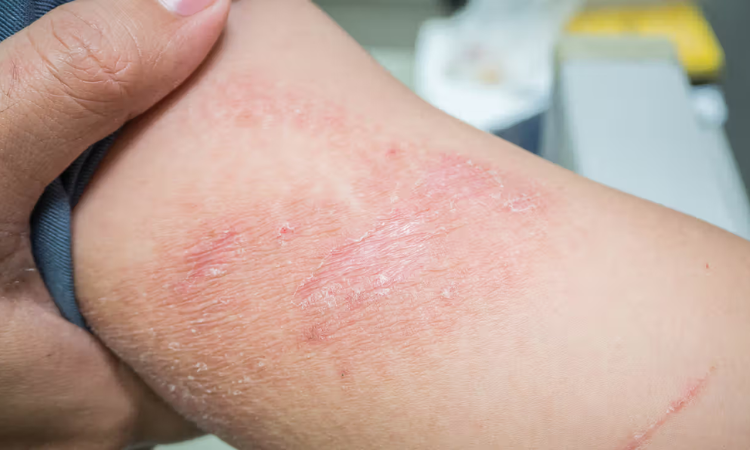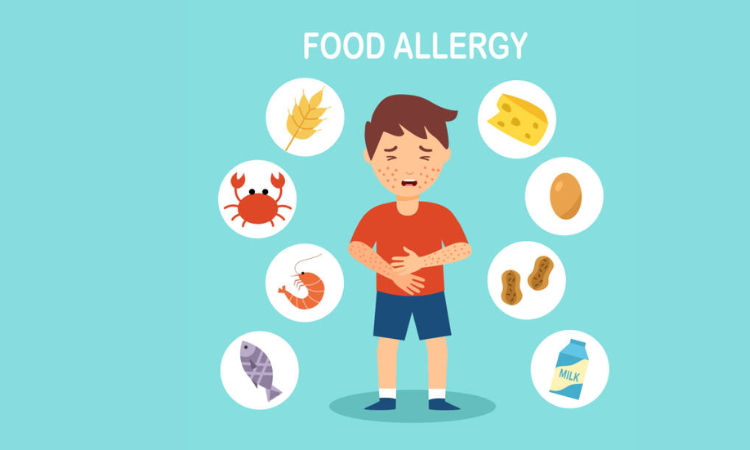An aberrant immune reaction to an unharmful chemical known as an allergen is what causes a skin allergy. The immune system releases histamine and other chemicals when the skin comes into touch with an allergen, which leads to inflammation and other symptoms.
Types of skin allergies
Skin allergies come in a wide variety, however, some of the more prevalent ones are as follows:
- Atopic dermatitis or eczema
- Urticaria Hives
- Dermatitis from contact
- Insect stings and bites
- Drug Sensitivity
- Food Intolerance
- Psoriasis
Common Skin Allergy Types Illustrated
A. Atopic dermatitis or eczema

Chronic eczema is a skin disorder that results in dry, itchy skin. It frequently comes with a rash that may be red, bumpy, or irritated. Although eczema can affect any region of the body, it most frequently affects the hands, feet, and face.
No such image. I apologize, but Bard is untested.
B. Urticaria (hives)

Anywhere on the body, hives are raised, and itchy lumps on the skin. They are frequently brought on by an allergic response to a meal, drug, or other item. Hives may appear and disappear rapidly or they may persist for a few days.
No such image. I apologize, but Bard is untested.
C. Contact Dermatitis

A rash known as contact dermatitis develops when an allergen or irritant comes into touch with the skin. Harsh chemicals, soaps, and detergents are examples of irritants. A few examples of allergens are nickel, latex, and poison ivy. Usually within 24 hours of exposure to the allergen or irritant, contact dermatitis manifests itself.
D. Stings and insect bites

Redness, swelling, stinging, and discomfort are just a few of the skin reactions that can result from insect bites and stings. Insect stings and bites can cause severe allergic reactions in certain people.
E. Drug Allergy

An allergic reaction to a drug is referred to as a drug allergy. The severity of a drug allergy can range from minor to fatal. Hives, redness, swelling, difficulty breathing, and anaphylaxis are a few signs of a drug allergy.
F. Food Allergy

An allergic reaction to food is known as a food allergy. Children are most frequently affected by food allergies, but they can appear at any age. Food allergies can cause hives, rash, swelling, breathing problems, and anaphylaxis as symptoms.
G. Psoriasis

A persistent skin disorder called psoriasis results in red, scaly patches of skin. Any area of the body can develop psoriasis, although the scalp, elbows, knees, and back are the most frequently affected.
Allergy Diagnosis and Treatment
Skin allergy tests used to make a diagnosis
The diagnosis of skin allergies can be made using a variety of tests. These tests consist of:
- Skin prick test: In this test, a tiny needle punctures the skin with a tiny amount of an allergen. An itchy, red bump will develop at the test location if the subject has an allergy to the allergen.
- Patch testing: In this procedure, little patches of skin are covered in allergens. The skin is examined for reactions after the patches have been worn for a few days.
- Blood test: This test quantifies the quantity of allergen-specific antibodies present in the blood.
Options for Skin Allergy Treatment
The type of allergy and the intensity of the symptoms will determine the best course of treatment for skin allergies. Typical therapies include:
- Medication purchased without a prescription: Medication purchased without a prescription can assist in reducing itching and irritation. Examples include calamine lotion and hydrocortisone cream.
- Prescription drugs: Prescription drugs can be used to treat more severe cases of skin allergies, including oral corticosteroids and antihistamines.
- Psoriasis and other skin disorders can be treated with phototherapy, a sort of light therapy.
- Immunotherapy, commonly referred to as allergy shots, can be used to assist persons with severe allergies in building up a tolerance to allergens.
Prevention
Wearing the proper protective equipment
Wearing protective gear, such as long pants, long sleeves, and a hat, will help to shield your skin from allergens and insect bites while you are outside. Make sure you are wearing gloves and other safety equipment if you are working with severe chemicals.
Keeping Away from Potential Irritants
You can take a number of steps to limit your exposure to potential irritants, such as:
- Using gentle detergents and soaps
- Ahttps://www.beaglesaresweet.com/is-beagle-a-good-family-doghttps://www.beaglesaresweet.com/what-is-the-laziest-dog-breedvoiding strong chemicals like ammonia and bleach
- When performing housekeeping, gloves
- Avoiding hot showers and baths
- Adding moisture to the air in your house by using a humidifier
Conclusion
There are several things you can do to avoid and treat skin allergies, despite the fact that they are a prevalent issue. A dermatologist or allergist should be consulted for a diagnosis and course of therapy if you have a skin allergy.